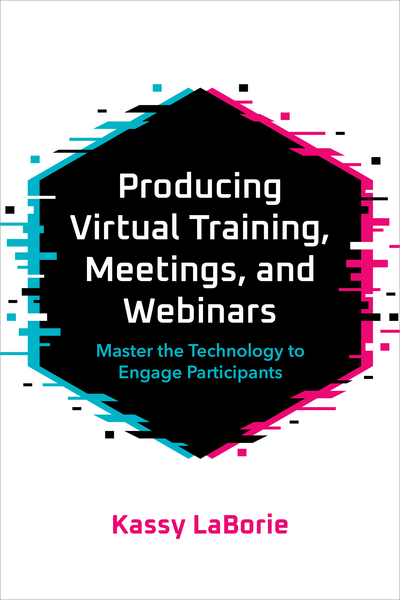ATD Blog
Producing Virtual Training, Meetings, and Webinars: Q&A With Kassy LaBorie
Wed Jan 06 2021

As trainers have quickly turned to technology and web conferencing software to support the rapid shift from in-person events to virtual meetings, trainings, and webinars, most have encountered a new and very real challenge of simultaneously delivering content and teaching learners while navigating technology. In Producing Virtual Training, Meetings, and Webinars: Master the Technology to Engage Participants (ATD Press, January 2021), virtual learning expert Kassy LaBorie provides facilitators—learning professionals, presenters, and businesspeople—with the knowledge and skills they need to take charge of the technical aspects of using web conference software to successfully run virtual events every day.
What is “producing” and why write a book focused on it for virtual training?
While it’s true that the existing books about virtual training and webinar delivery (including my own, Interact and Engage) include messaging around using a producer, I felt there was simply not enough time devoted to all the details that go into the successful production of engaging live online delivery. It was time we focused on what it is exactly, the skills needed to perform the tasks and the role well, and all the details, strategies, and approaches necessary to effectively produce live online training, meetings, and webinars that actually engage.
Virtual session production—a key to engagement for online trainers, presenters, and meeting leaders—is the planning, setup, in-session management, and follow-up of all the logistical and technical details required of a successful virtual event. Production refers to the tasks required to deliver an online training, webinar, or meeting that are not directly connected to the content but rather to the delivery of it in the live online environment. To answer who then is doing what in a simple way, it looks like this:
Trainer/presenter/meeting leader: Content and meaning | Producer/host/meeting moderator: Technology and logistics |
Who should read this book and what will they learn?
Prior to 2021, I would have said business professionals who need to plan, design, and deliver virtual instructor-led training, online meetings, and webinars, but the truth is that everyone should read this book. Anyone who needs to run a meeting using Zoom, Webex, Teams, and so forth will benefit from reading it. This book will help them make sense and take care of many of the things that are causing confusion and delay. They will learn what types of web conferencing platforms exist, which will help them to better plan. They will learn the most common features used to create interactions which will help them design. They will learn how to troubleshoot the most common problems with each of those features, which will help them feel more confident. Maybe most importantly, they will learn how to be more effective at getting someone to help them by being clearer on exactly the type of help they need.
Given the prevalence of virtual training in our world today, how does a focus on virtual production change what we are already doing on our own? How does it differ from the regular tasks a virtual trainer must do anyway?
Virtual trainers and presenters are struggling to do more, to do better, and to enjoy it more as well. Presently, most are running live online sessions by sending links to get everyone connected, focusing on webcams and virtual backgrounds, and hoping participants will stay on camera the whole time so we can see that they are engaged. But we need to ask what is engaging them. There is so much more we can do in a live online environment than appear on webcams, and while this is wonderful and helpful, it is not proof of learning. We would do better to plan thoughtful interactions designed for the online environment and made for immediate application.
The features and capabilities of a web conferencing platform are a lot to learn and certainly a lot to ask of one person to manage when live in front of a group of participants. Without using a producer or focusing on the separate production tasks, we run the risk of being overwhelmed and resorting to lecture, leaving participants underwhelmed or even bored. Trainers and presenters must focus on the content instead of being distracted by all the technology it takes to share it.
Could you share a specific example of when a producer or a focus on production changed the outcome of the virtual training?
Here are two examples of when a focus on production changed and improved the outcome of the virtual training:
Surveying an audience and putting participants into small groups. We’ve all attended a webinar where the presenter is trying to locate the polling controls as they fumble their way through it verbally. Rather than focusing on the purpose of surveying the audience and responding to the answers as it pertains to the content, the audience listens to the confused presenter nervously locate the polling controls. Simply requesting a producer launch the survey would allow the presenter to focus on the purpose and the results.
Using breakout rooms to let people work together in small groups. This requires proper explanation for participants to understand what they are to do in their group to be successful. It also often works well when a trainer can visit the rooms then have enough time to properly debrief each group’s experience. Setting up breakouts in the web conferencing platform takes as much focus technically as it does instructionally. One must decide how many groups, with how many people, and which people, as well as how much time they will need to be in there. One must know where to click to create these, have the time to do it, explain the details and assignment to the participants, communicate with them while they are away in the groups, and get them in and out of each room on time. Many trainers choose to skip this entire process and lecture or have a full-group discussion instead. We all miss out. A producer is the key to success with small groups effectively using breakout rooms.
Can you share one big idea from the book to help each of us better produce our own sessions?
In chapter 9, “Working Together in a Partnership,” I outline three types of producers. If your work situation cannot allocate a dedicated person to lead on all the production tasks, regardless of the reason, then I have a game-changer for you—the start time producer.
The start time producer is one that almost every organization can implement right away because it is someone who helps you when you most need it—in the beginning. This type of producer assists online meetings, webinars, and virtual training sessions to help everyone connect and get the session off to a good start. They do not stay for the entire session but often remain available to be called back in if assistance is needed. The two most difficult technical issues are accessing the web conferencing software or session itself and connecting to the audio. The first moments of any online session are the most fraught with technical problems but also the most important time to make a positive first impression on the attendees. Given these two reasons, appointing someone in the role of a start time producer will be highly beneficial for everyone involved.
**
About the Author
Kassy LaBorie** is the founder and principal consultant at Kassy LaBorie Consulting. She is a virtual classroom master trainer specializing in developing trainers to be engaging and effective when facilitating programs in platforms such as Zoom, Webex, and Adobe Connect. She has worked with many Fortune 500 firms in a wide range of industries and sectors, including hospitality, pharma, energy, government, NGOs, and nonprofits. She also trains and coaches producers, the virtual classroom trainer’s partner in effective facilitation, as well as instructional designers tasked with creating or converting content for virtual classroom delivery. In addition, she advises learning and development leaders in areas including virtual classroom strategy, technology selection, and logistics. She has more than 20 years of experience in passionately helping organizations, learning teams, and training professionals successfully move to the virtual environment.
She co-authored Interact and Engage! 50+ Activities for Virtual Training, Meetings, and Webinars (ATD Press, 2015).
About ATD and ATD Press
The Association for Talent Development (ATD) is the world’s largest association dedicated to those who develop talent in organizations. ATD’s members come from more than 120 countries and work in public and private organizations in every industry sector. ATD Press publications are written by industry thought leaders and offer anyone who works with adult learners the best practices, academic theory, and guidance necessary to move the profession forward. For more information, visit td.org/books.

Producing Virtual Training, Meetings, and Webinars: Master the Technology to Engage Participants
ISBN: 9781950496259 | 228 Pages | Paperback
https://www.td.org/product/book--producing-virtual-training-meetings-and-webinars/112013
To order books from ATD Press, call 800.628.2783.
To schedule an interview with Kassy LaBorie, please contact Kay Hechler, ATD Press senior marketing manager, at [email protected] or 703.683.8178.
